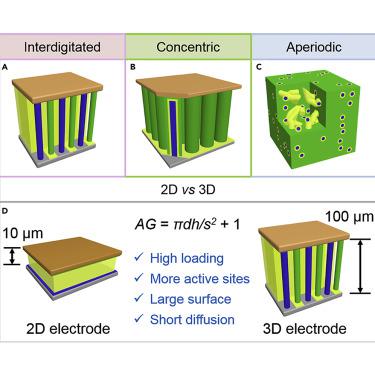Matter ( IF 17.3 ) Pub Date : 2020-06-03 , DOI: 10.1016/j.matt.2020.04.020 Jiangfeng Ni , Alvin Dai , Yifei Yuan , Liang Li , Jun Lu

|
Ubiquitous implementation of microelectronics in microelectromechanical systems requires stable power supplies and necessitates development of on-chip miniature power sources, such as microbatteries. However, conventional thin-film batteries exhibit limited surface area and sluggish diffusion kinetics with insufficient energy and power density. In contrast, three-dimensional beyond-lithium (e.g., sodium, zinc, aluminum) battery architectures can significantly enhance the areal energy and power and meanwhile maintain the low-cost mass production. Despite this, the future of beyond-lithium systems is being questioned as they each present shortcomings. In this Perspective, we discuss scientific advancements in reaction kinetics control, electrochemical stability improvements, and reaction mechanism understanding in three-dimensional beyond-lithium battery systems and call for intensive research efforts to address the challenges and develop strategies that can pave the way toward their commercialization.
中文翻译:

锂离子以外的三维微型电池
在微机电系统中无处不在的微电子实现需要稳定的电源,并且需要开发芯片上的微型电源,例如微电池。然而,常规的薄膜电池在能量和功率密度不足的情况下显示出有限的表面积和缓慢的扩散动力学。相比之下,三维超锂电池(例如钠,锌,铝)架构可以显着提高面能和功率,同时保持低成本的批量生产。尽管如此,由于锂以外的系统各自存在缺点,因此受到质疑。在此观点中,我们讨论了反应动力学控制,电化学稳定性改进,











































 京公网安备 11010802027423号
京公网安备 11010802027423号